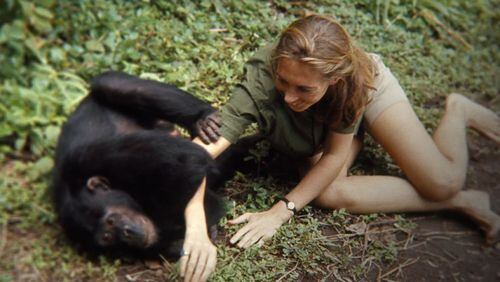Documentary filmmakers often spend their entire lives searching for a single photograph or tiniest bit of film they can use as the central core for their project. Brett Morgen’s plight was that he had an abundance of footage to use to create “Jane,” a documentary that looks at the life and work of Jane Goodall.
The production, produced with National Geographic Documentary Films, was made using more than 140 hours of never-before-seen 16 mm footage that has been in the National Geographic archives for more than 50 years. The majority of the film was shot by Hugo van Lawick, the renowned nature photographer who was married to Goodall from 1964-1974. That footage has been blended with Goodall’s own words and set against a majestic score by Philip Glass.
There’s a deep sense of intimacy as the story unfolds because the footage was captured by van Lawick. It’s the same kind of uncensored imagery that comes from home movies but these images were captured by one of the greatest nature photographers in a world of flora and fauna just an apple tree away from being an Eden.
Goodall was selected by Dr. Louis Leakey (the paleoanthropologist and archaeologist who was also behind the work of Dian Fossey) in 1957 to travel to Africa for a six-month study of chimpanzees. Leakey’s theory was that an observation of the primates would offer an insight into the way primitive man acted. He didn’t want to send an academic because they would look at this world through the haze of scientific theory and research. That’s why he opted to send Goodall who was a 26-year-old secretary with no formal training.
What Goodall brought to the research was a philosophy that “success comes with determination and hard work.” She also brought a passion for animals that drove her to go beyond the standard scientific approach and observe the world of the chimpanzee with a passion and respect for each creature. A six-month study turned into a lifetime of work for Goodall.
Morgen and cinematographer Ellen Kuras went to Tanzania where they spent two days filming an interview with Goodall who at 83 recalls her work in crystal clear detail. It’s not only her words that relate Goodall’s deep love and concern but those feelings are beautifully documented through the archival footage.
The only slight weakness with the documentary is that Morgen loses his objectivity in a few places. He never presses on some of the negative issues that surrounded Goodall’s work such as her lack of training to make such observations and the impact her presence has on the group. But that’s like talking about a tick that’s latched on to a wildebeest. It’s an annoyance but doesn’t distract from the power of the larger beast. The fact she did all the research without being a trained academic makes Goodall far more accessible to the average person. Not everyone is going to get the kind of degree needed to be able to devote their lives to such a singular study but Goodall shows that all an average person needs is a strong will, deep determination and an unfettered passion for whatever subject matter is selected.
MOVIE REVIEW
“Jane”
Grade: A
Starring Jane Goodall. Directed by Bret Morgen.
Unrated. Check listings for theaters. 1 hour, 30 minutes.
Bottom line: A documentary with a deep sense of intimacy






